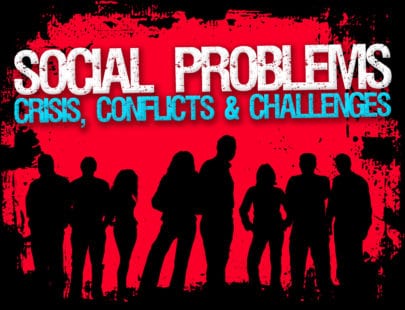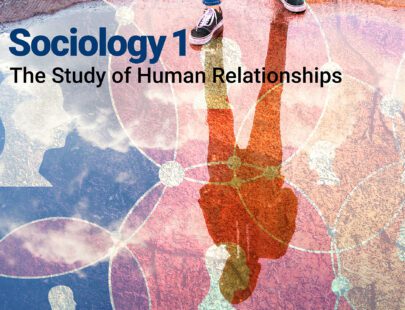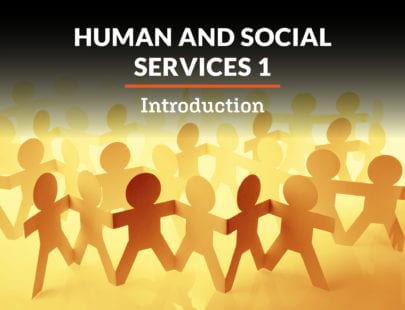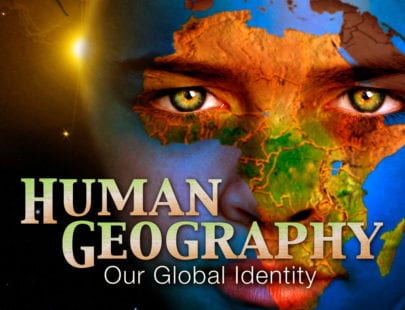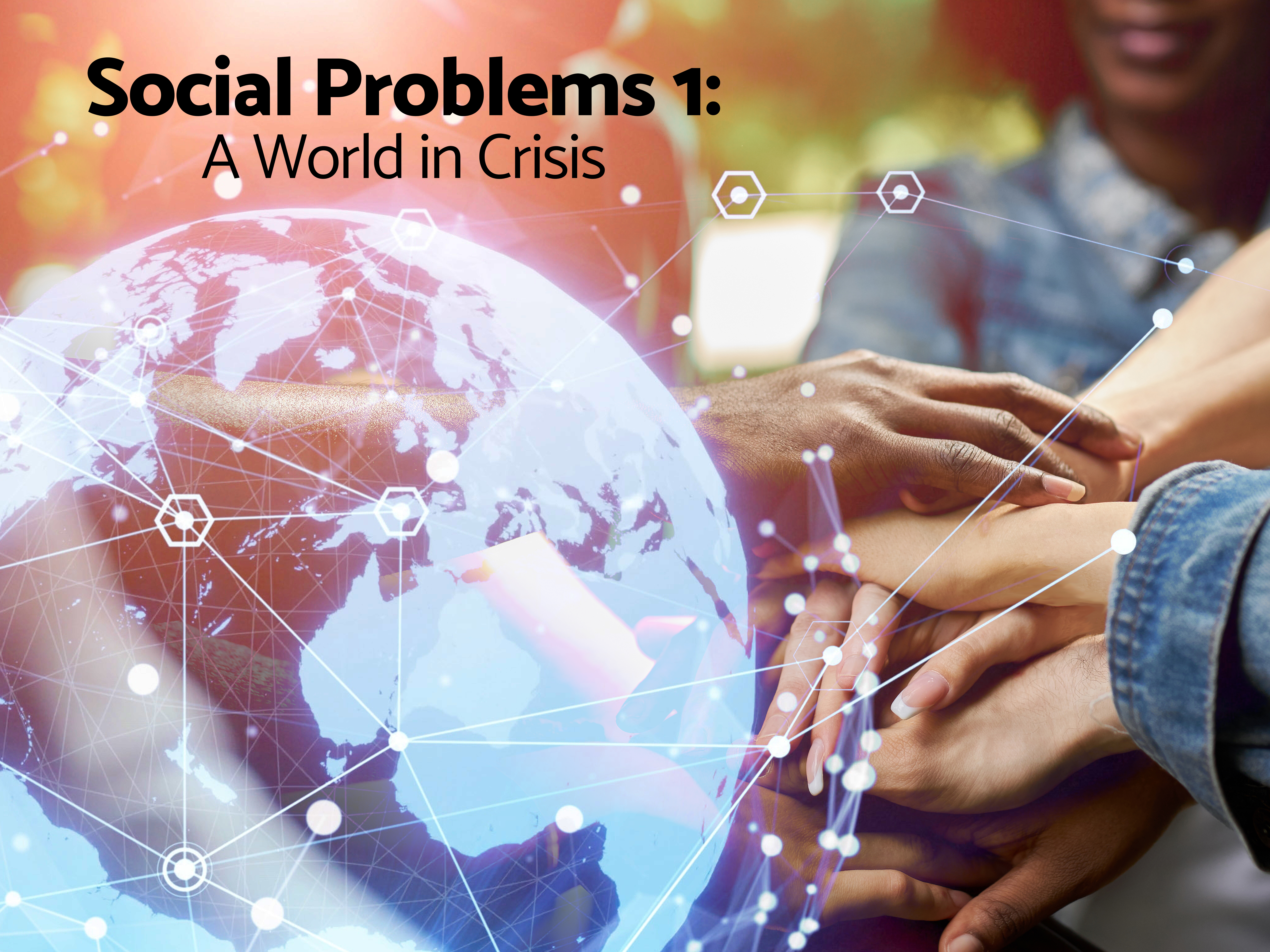
Social Problems I : A World in Crisis
Do you dream of a better world? Do you ever wonder how you can contribute to positive change? Whether you’re passionate about solving larger problems in society or promoting better solutions to improve the outcome for a few, this is the course for you. By becoming a social scientist, you’ll learn how to recognize and call attention to social problems. From issues surrounding mass media, poverty, health, education, our justice system, the environment, and more, you’ll learn how to acquire and assess information so you can seek solutions and advocate for real change regarding the societal challenges that mean the most to you. After all, we only have one world; why not strive to make it a better place?
Units at a Glance
Unit 1: Understanding Social Problems
Jimmy Darts is a social media personality you may have seen online. In the content he shares, he finds individuals in need or who have fallen on hard times and gives them money, takes them on a shopping spree, or goes with them on an adventure. Jimmy has targeted the social problem of poverty and is working, one individual at a time, to ease the burden of this strain on both the individual and society. Poverty is likely a problem you have also observed and one in which, like Jimmy, you could work to make a positive change. In this unit, you will learn many of the basic elements of social problems. As you learn more about them, you will begin to recognize the social problems around you and see how you can become part of the solution.
What will you learn in this unit?
- Identify social problems and their common elements
- Describe how social problems evolve over time and across cultures
- Explain varying perspectives central to understanding social issues
- Discuss the key issues in studying social problems
- Analyze the development of solutions for social problems
Unit 2: Mass Media
In 2023, the social media company Twitter, known today as X, was investigated by the US House Committee on Oversight and Accountability. The committee found the social media company had violated free speech by censoring information. Twitter had used its platform to control which information was available to users, favoring material that correlated with mainstream media and often blocking posts that shared conservative messages. Did you know media companies sometimes control the content you do or don’t see on your feeds? How do you think this affects your life? Consider how censorship of information might lead to social problems. In this unit, you will learn about mass media and the impact it has on public thought and behavior. You will come to understand why censorship of information is such a serious issue.
What will you learn in this unit?
- Identify what constitutes mass media
- Describe how mass media is distributed and monitored
- Explain the importance of assessing the quality of information
- Discuss social problems in mass media and potential solutions
Unit 3: Confronting Poverty
Oprah Winfrey is one of the wealthiest individuals in the world today. However, her life was not always as glamorous as it is now. When she was younger, Oprah would sometimes wear potato sacks because her family was unable to afford clothes for her, and she was often left in dangerous and harmful situations. Like millions of children around the world today, Oprah grew up in poverty. In this unit, you will learn more about poverty, what it is, the impact it has, and how we can mitigate the effects of this devastating social problem.
What will you learn in this unit?
- Describe the history of poverty and its existence in the world today
- Analyze the causes of poverty
- Explain the impact poverty has on individuals and society
- Identify potential solutions to poverty and barriers to improvement
Unit 4: The Power of Knowledge
Both the book and movie Freedom Writers follow the story of teacher Erin Gruwell as she takes on a teaching position at Long Beach, California’s Woodrow Wilson High School—a declining school filled with racial tension. The narrative depicts the challenges she faces with a group of students labeled incapable of learning. Deeply invested in helping the students succeed, she finds material that relates to the students’ lives, inspiring them to develop and grow. Based on true events, this story illustrates just one example of how education can change lives as well as some of the obstacles students and teachers may need to overcome to succeed. In this unit, we will explore some social problems and issues in education as well as possible solutions that involve schools around the world.
What will you learn in this unit?
- Discuss how access to education varies over time and location
- Explain the evolution of education in the United States
- Examine barriers to quality education for all
- Explore solutions for making education more attainable for all
Unit 5: Issues in Health Care
Médecins Sans Frontières (MSF), also known as Doctors Without Borders, sends doctors all over the world to provide medical care to those in great need. They are first responders who enter dangerous situations and doctors who travel to areas where limited, if any, healthcare services are available. These doctors step in when individual health is threatened due to conflict, disasters, epidemics, or other medical issues. MSF is just one organization striving to alleviate the pain and suffering due to medical issues worldwide. In this unit, you will learn about social problems related to health challenges and how they might be improved.
What will you learn in this unit?
- Discuss challenges with the administration of health care
- Analyze the most common health conditions individuals face
- Explore how individuals can live healthier lives
- Identify solutions to improve the state of health and health care
Unit 6: Crime and Punishment
The ride home on December 17, 2021, turned into a nightmare for the Simmons family. Four family members and a friend were coming home from 17-year-old Christopher’s basketball game. While driving on the interstate, a car entered their lane going the wrong way and hit the family head-on. The mother, who was driving, survived, as well as the family friend, but the other three passengers in the vehicle were all killed. The crash was caused by a drunk driver, who also died in the accident. This crime cost lives and affected families and communities. Crime takes many shapes and forms. However, a consistent element of crime is that it hurts people. In this unit, you will learn about the impact of criminal behavior as well as factors that must be considered when addressing this social problem.
What will you learn in this unit?
- Discuss what crime is and the impact it has on society
- Describe the origins of criminal behavior
- Analyze various systems of justice and methods of addressing crime
- Evaluate solutions for addressing criminal behavior
Unit 7: Protecting the Earth
In January 2016, construction was approved on a massive pipeline that would carry oil out of North and South Dakota, through Iowa, and into Illinois. Repeated legal concerns were raised regarding the construction as it was alleged it would threaten water supplies and destroy land sacred to Native Americans, while also breaking previously established treaties. In the fall and winter of the same year, with no progress in the legal fight to halt the pipeline, protestors risked physical harm to demonstrate their opposition to the construction. Despite controversy and opposition, the pipeline was built and is still operating today with the oil being refined and used as gasoline for vehicles. This demonstrates a core issue of environmental concern in the world today: is the cost of destroying natural resources worth the benefit of the goods and services they provide? In this unit, we will explore some of the most pressing issues affecting our environment.
What will you learn in this unit?
- Identify historical factors leading to the current state of the environment
- Describe the impact a growing population has on Earth
- Explain the damage human action is causing the environment
- Discuss actions you can take to contribute to a healthier environment
Unit 8: Turning to Violence
The organization Spotlight Humanity has an unending social media feed of hungry children and broken families. Reels show children in tears, talking about their difficult living situations. Many of these children are orphans, some working hard to provide for their siblings, often going hungry when food is not available. War and conflict in the Middle East, where Spotlight Humanity works, have left children in the region devastated. Ongoing conflicts, political unrest, and ethnic violence have placed these children in desperate situations, fighting daily for basic survival. Conflicts such as these have been present throughout history, and the result is always the same: terrible pain for the most innocent. In this unit, you will learn more about violence as a social problem and the destructive impact it has on society.
What will you learn in this unit?
- Discuss the causes and impacts of war
- Describe terrorism, why it takes place, and how it affects society
- Analyze mass shootings and the factors that contribute to them
- Evaluate how violence and its effects can be reduced
Required Materials
Physical
- Video recording device
Software
- Word processing software
Optional
- Art supplies
- Audio recording device
- Graphic design software
- Poster board
- Presentation software
- Spreadsheet software
